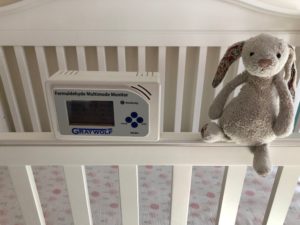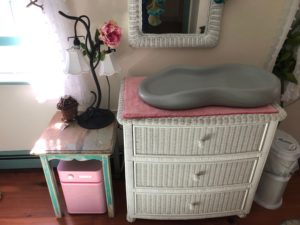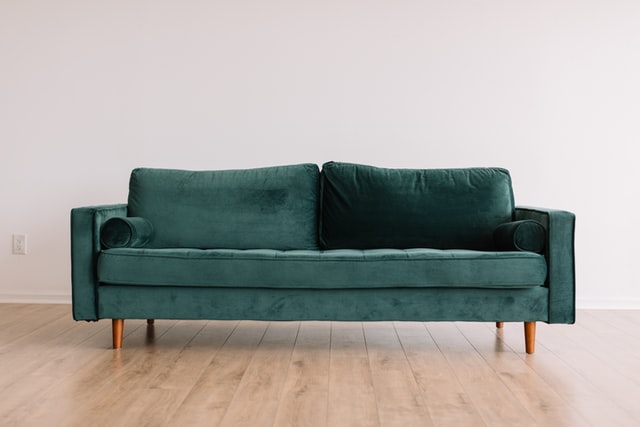New furniture can off-gas harmful cancer-causing chemicals and formaldehyde for years. Unfortunately, baby furniture, built in cabinetry, office desks and many products made overseas are loaded with volatile organic compounds (VOCs). Furniture off-gassing will accumulate in a home, especially a tight, energy efficient home resulting in adverse health effects like headaches, rashes, eye, nose and throat irritation.

What is Off-Gassing?
Formaldehyde furniture off-gassing is a serious problem, but you may not know exactly what this is. Products that contain VOCs release these chemicals through a process known as “off-gassing” and sometimes “out gassing”. There are a couple of things that can affect the off-gassing process. Off-gassing can be higher right after you purchase and open the box with furniture in it and chemical processes can speed up due to high temperatures.
There is no definitive timeframe for the off gassing. VOCs can continue to off-gas for the entire lifespan of the product. The majority of furniture off-gassing for VOCs takes place in the first several years of owning the product. The time period for off-gassing with VOCs can greatly depend on the materials used to manufacture the product.
SVOCs (Semi-Volatile Organic Compounds) can go through the off-gassing process a lot slower and throughout the lifespan of the item. Watching out for these can be just as important as it can be for watching out for VOCs.
What Furniture Can Have Off-Gassing?
Formaldehyde can be found in items that you probably never considered before. It is a very common chemical that is used in the manufacturing of composite wood products such as particle board, hardwood plywood, and MDF (medium-density fiberboard). It can also be used in the adhesives that are used to hold the furniture together. There is some evidence that plywood and particle board tend to have higher concentrations when compared to solid wood products as a result of their porous nature. You should know that while most of the off gassing of these products happen during the first year, they can continually release formaldehyde for the entirety of their lifespan.
One of the scariest places furniture off-gassing occurs is within your baby’s nursery. The various pieces of furniture from your nursery can emit VOCs like formaldehyde, like the crib, rocker, and the dresser. This can be scary to consider as a parent who wants to do whatever you can to protect your children.

Exposure to formaldehyde can cause a variety of different issues, for both the short-term and the long-term. Short-term side effects include burning sensations in the eyes, nose and throat as well as watery eyes, coughing, wheezing, nausea, and irritation of the skin. Long-term exposure side effects can include cancer. Purchasing older furniture will reduce your risk to formaldehyde exposure.
What parts of your furniture can have VOCs? Aside from cushions and mattresses, these can be found in:
- Frames and Tops
The various parts of furniture like the frames and tops of sofas, dressers, and consoles contain composite woods.
- Finishes
You need to watch out for the different finishes as these can be very high in VOCs. Melamine is a resin that is particularly high in formaldehyde, as this is an ingredient to make it.
Ways to Avoid Furniture Off-Gassing
Fortunately, there are things that you can do that will help you to reduce the formaldehyde exposure within your home. Avoid purchasing furniture made with urea-formaldehyde glues or labeled as UF. Looking at the labels before you buy items can be very useful here. Any furniture item made with pressed-wood products should meet the requirements for ultra-low emitting formaldehyde (ULEF) or NAF (no added formaldehyde). The products will also be labelled “No VOC/Low VOC”. When it comes to nursery furniture, there are Greenguard certifications that can show that the furniture items emit low or no levels of the hazardous VOCs. SCS Global Services is another organization that certifies furniture. These are some things to look for when you are reading the furniture labels.
Air Out
Another thing that you can do is to unwrap furniture outside or in a garage, if possible, for at least a week. If that’s not possible, you should leave doors and windows open as much as possible to keep the air in your home fresh. By doing this, you can go through the off-gassing process before you place the furniture inside of your home.
Think Amish
We recommend purchasing real natural wood products made in America. Natural wood products do not off-gas nearly as much as synthetic products made overseas. Alternatively, buying used is a great option for you and the environment. Make sure the older furniture still meets current safety standards. Keep your child safe by reading the certification labels on older cribs and dressers.
Avoid Particle Board
Avoiding any furniture made with particle board to avoid formaldehyde off-gassing. MDF (medium density fiberboard), pressed wood, and engineered wood will off-gas. Adhesives contain formaldehyde to bind materials together. However, you can purchase items labeled as “certified particleboard products”. We highly recommend running a medical grade carbon-based air cleaner to reduce furniture off-gassing like the Austin Air and IQair Brand purifiers.

VOCs are a problem for all types of furnishings in the home. By knowing what to look out for, you can ensure that you get the safest items for your home.






